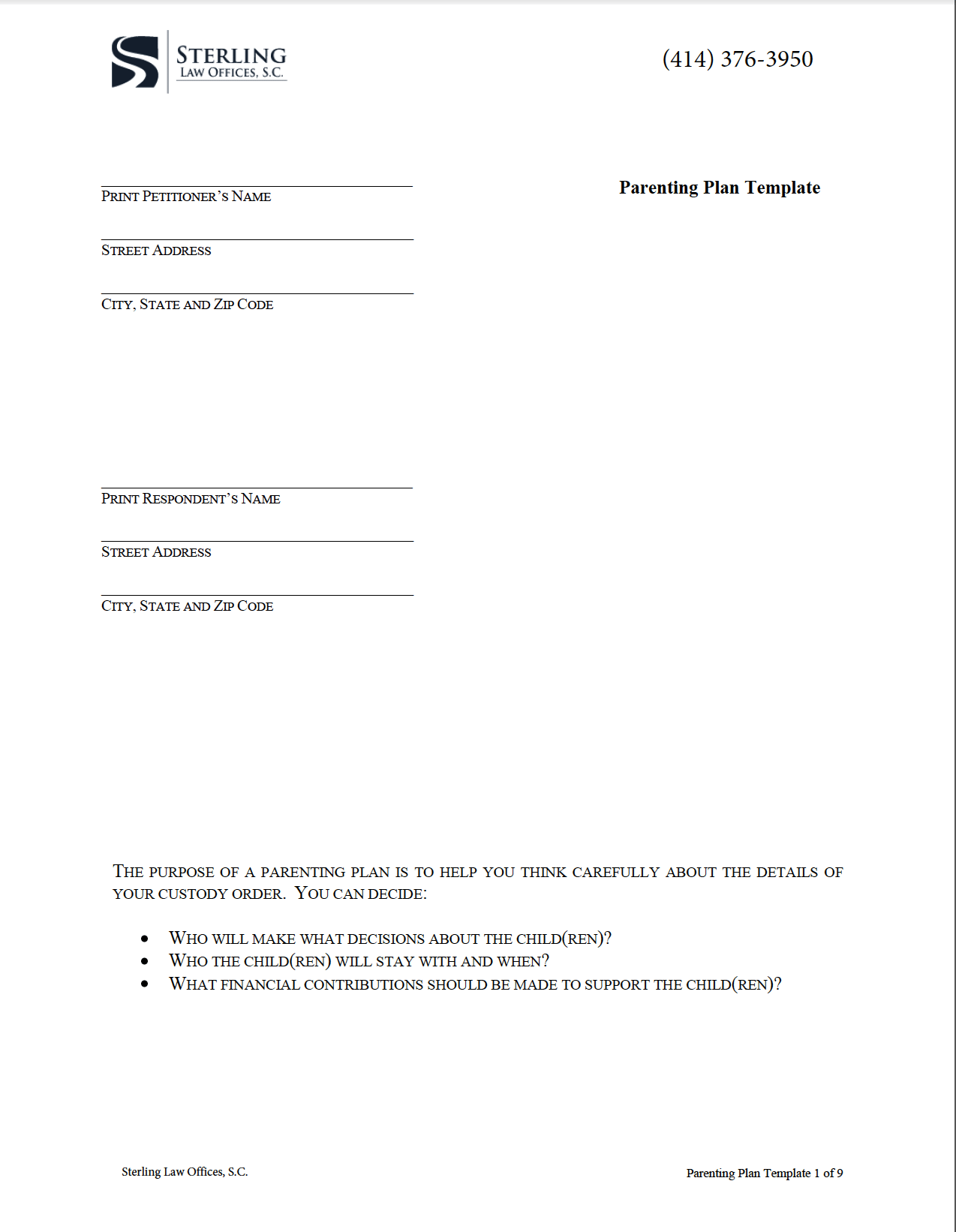Wisconsin Parenting Plan Template
The parenting plan is a factor the court considers when making a judgment on custody and placement if parents can’t agree on a parenting plan. Get the best possible outcome in your custody case by putting yourself in the best position to maximize time with your children.
When going through negotiations for child custody and placement, it's often very difficult for parents to come to an agreement. But if they cannot come to one eventually, the courts will decide. The courts presume it's in the best interest of the child to have access to both of their parents–this is where a parenting plan comes in.
To get an idea of what types of decisions you will need to make, download the above form. Filling out the form is a good way to prepare yourself for the conversations you'll need to have regarding your child's custody and placement.
What Is A Parenting Plan and Do I Need One?
The parenting plan outlines the responsibilities heach parent has for raising the child. Family court requires this for child custody cases and any divorce cases that involve minors.[1]
What Should I Include in a Wisconsin Parenting Plan?
In order for the court to accept the parenting plan, it will need to be filled out completely and include the information explained below. If you want to include anything that doesn't have a section in the parenting plan document, you can speak with your attorney or call Sterling Lawyers to get an attorney.
Different Plans for Different Kids
In some situations, parents may want different schedules depending on the child. If the parenting arrangements are different for some of your children, you should create a separate parenting plan for each child with different circumstances. When determining which children are involved, each child’s name, age, and where they live should be documented.
Specific Decision-Making Authority
When creating a parenting plan, the parent that makes decisions about major actions is recorded. This determination is the backbone of legal custody. Some examples of major decisions include diet, religious/spiritual affiliations, medical care, mental health care, school choice, and extracurricular activities.
Both parents or an individual parent may be involved in the decision-making process: it does not have to be one or the other. In addition, the decision-making process must be outlined because it's where parents state how they plan to carry out any jointly made decisions. Who has this authority depends on what is in the child's best interest.
Child Placement
Physical custody, or placement, determines where the child will live. This is typically done by looking at the days of the week and describing which days and times the children will be with each parent. The schedule that you create can be weekly, bi-weekly, or something else that is agreed upon.
Within this schedule, drop-off times, pick-up times, and locations are set up by the parents. Tardiness should also be addressed by writing down how long the other parent should wait if the other parent does not show up on time. Lastly, if extra travel costs (taxi, train, plane, etc.) arise in order to reach placement, the parenting plan addresses who will be responsible for those expenses.
Temporary Changes in Schedules
From time to time, one parent might want or need to rearrange the parenting time schedule. This may be due to a number of reasons such as work, family, vacations, or other outside factors. In the parenting plan, there is space to define if changes can be made at all, how far in advance a proposed change needs to be communicated, and the mode of communication to propose changes and to respond to proposals.
Extracurricular Activities and Holiday Placement Schedule
A critical and often emotional part of creating a placement schedule is dividing holidays/special occasions and extracurricular activities. Below are some examples of how to create a holiday schedule.
- Holidays Every Other Year: This option assigns certain holidays to each parent during even years and then swaps the holidays and special occasions in odd years.
- Split the Holiday in Half: This plan splits the day of the holiday in half like morning and evening, so the children can spend time with both parents during the holiday celebrations.
- Schedule Holiday Twice: This plan requires one parent to set a different day for the assigned holiday. For example, parent A would celebrate the 4th of July on the 4th, and parent B would celebrate it on a different day. Then parent B would have the child on Thanksgiving while parent A celebrates Thanksgiving on another day.
- Assign Fixed Holidays: For example, if parent A is assigned Thanksgiving as a fixed holiday, then parent A could always have the child on New Year's Eve. This is great when parents have different holidays they care about.
Child Expenses
Expenses of the child or children are usually broken up as a total cost percentage meaning each parent has to pay a certain percentage of the final cost of specific things like medical expenses. The percentage breakdown provides transparency for how much each parent is expected to cover. The following are some other examples of expenses that should be addressed within the parenting plan:
- Child Care
- Child Support
- Taxes
- College
Maintaining Contact with the Other Parent
Communication is important when trying to co-parent and work as a team especially when working towards major decisions in the child's life. In the parenting plan, both parents determine if they will remain in contact with the other parent and how that communication can occur. Additionally, regardless if parents choose to stop communication, there must be a way for each parent to communicate with the children when they are with the other parent. The parenting plan allows both parents to agree on when and how the child communicates with their other parent.
For Immediate help with your family law case or answering any questions please call (262) 221-8123 now!
Factors the Court Considers When Ruling on Parenting Plans
The court considers the entire document and specifically looks at each parent's work schedule, where the child goes to school, where the child goes to daycare, where the child lives, and how close important family members (like grandparents) live. Outside of the parenting plan, if the court has to decide on the custody and placement of the child, they decide by reviewing all relevant child placement factors.[2]
Can a Child Decide Which Parent to Live with in Wisconsin?
In Wisconsin, children cannot decide where they live but the courts do take the child's preference into consideration. The weight the court gives to the child's preference depends on the child's age and the reason for the preference. Reasons such as relaxed discipline at one parent's house or one parent giving more gifts will not be seen by the court as substantial reasons for awarding placement to one parent over another.
The court will evaluate what is in the best interest of the child which is assumed to be as close to equal time with each parent as possible. If the parents cannot agree on a schedule, a guardian ad litem may be appointed to represent the best interests of the child and give the court a recommendation for custody and placement.
How Will Agreeing Or Disagreeing Affect My Parenting Plan in Wisconsin?
If both parties are not able to reach an agreement on their own, they try mediation as a way to reach an agreement. However, if that does not work, and both parties tried their best efforts, they may submit their own proposed parenting plans separately to the court.
If you cannot agree on a parenting plan, the court will decide for you, so either way, you will likely be co-parenting. If you were unable to agree, here are some co-parenting tips.
Are you ready to move forward? Call (262) 221-8123 to schedule a strategy session with one of our attorneys.
Considerations
What Is a Placement Schedule?
Placement refers to the physical placement of the child or children. The placement schedule provides a structure for both parents to determine where the physical placement of the child is. The primary consideration that determines the placement is the best interest of the child.
What Are Some Examples of Placement Schedules?
Deciding on a placement schedule can be very difficult for parents who are accustom to seeing their children every day. Schedules are unique to each situation, but here are good places to start.
50/50 Schedules
- Alternating Weeks
- 2 Weeks Each
- 3-3-4-4
- 2-2-5-5
- 2-2-3
- Alternating Every 2 Days
60/40 Schedules
- Every Weekend Extended
- 4-3
70/30 Schedules
- Every Weekend
- 5-2
- Every 3rd Week
- Every 3rd Day
80/20 Schedules
- Alternating Weekends
- 1st, 3rd, and 5th Weekends
- 2nd, 4th, and 5th Weekends
- Every 3rd Weekend
Frequently Asked Questions
How is custody determined in Wisconsin?
Child custody is either agreed upon by the parents or the court decides for them if they cannot come to an agreement.
What is the best 50/50 custody schedule?
The best 50/50 schedule is what is best for you and your child. You have to take into account how long you are comfortable being away from your child and how much time you are able to devote to them.
Is Wisconsin a mother state?
Wisconsin is not a mother state. Once paternity is established, both parents have equal rights to the custody of the child.
What are the chances of a father getting 50/50 custody?
The father is pretty likely to get 50/50 at first because that is the courts assumption. He will not get that custody if it is not in the child's best interest. It will not be in the child's best interest if the father is an unfit parent.
What is considered an unfit parent in Wisconsin?
An unfit parent is when the courts deem a parent to be a threat to the physical, mental, or emotional health of the child.
If both parents share custody does anyone pay child support?
In situations where parents are sharing custody of a child, child support will be determined based on the amount of time that the child is with each parent and each parent's income. Child support can be calculated using the child support calculator.
What can I expect from temporary orders?
Temporary orders give directions for an issue that must be resolved quickly and gives temporary authority until the formal case can be finalized. Temporary orders can be issued for many reasons, whether it is to negotiate child placement, spousal support, or health insurance.
Temporary orders do not always become permanent orders, but there is a good chance of them being part of the final divorce orders. It is important to consult an attorney before agreeing to any temporary orders regarding child issues.

